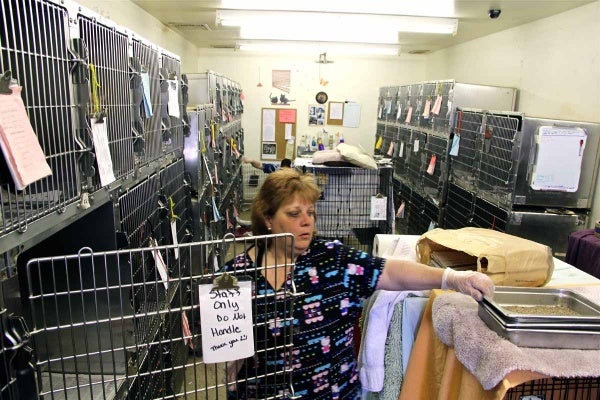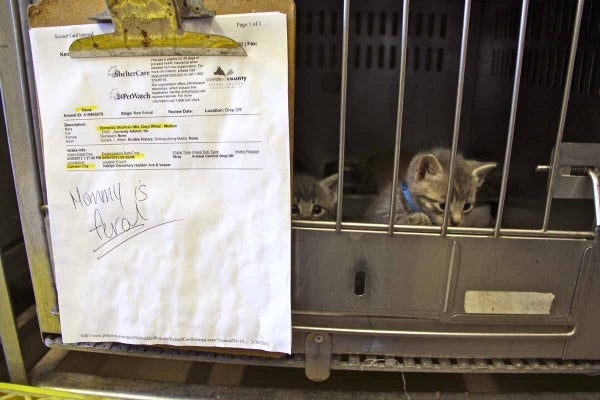Coming together in Camden County to curb the feral cat population
-

A kitten shares a cage with its mother at the Camden County Animal Shelter in Blackwood. Both are up for adoption. (Emma Lee/for NewsWorks)
-

Michele Dains cleans cages in the crowded cat room at the Camden County Animal Shelter in Blackwood. The shelter has nearly 100 cats and more are expected as the warm weather brings kittens. (Emma Lee/for NewsWorks)
-

Three kittens share a cage with their mother at the Camden County Animal Shelter in Blackwood. Adult feral cats are unsuited for adoption and must be euthanized. The kittens can be adopted. (Emma Lee/for NewsWorks)
-

Barb Giusti tends to newly neutered patients at the Camden County Animal Shelter in Blackwood. The facility is stepping up its trap, neuter, release (TNR) program because of increasing populations and limited space. (Emma Lee/for NewsWorks)
-

Camden County Animal Shelter Executive Director Lisa Ross spies a feral cat in a colony on County House Road. The shelter neuters members of such colonies and releases them, provided the colony has a caretaker. (Emma Lee/for NewsWorks)
-

Andrew Gershman, director of operations at Camden County Animal Shelter in Blackwood, holds a cage used to trap feral cats. (Emma Lee/for NewsWorks)
As county shelters face a rising tide of unwanted pets and towns grapple with soaring animal control costs, Camden County officials say it’s time for radical changes in the way municipalities handle their stray and abandoned animals.
In a bold move designed to quell pet populations, tamp down costs and prevent thousands of animals from being put to sleep, the county has proposed a series of initiatives for the 18 towns that share animal control services – including uniform animal control laws and county-wide trap-neuter-return programs for feral cats.
“It has been a continuous struggle for towns to keep up with the cost of animal control and animal shelters as the number of unwanted pets continues to rise,” said Gary Passanante, head of Camden County’s Division of Shared Services. “It’s a burden that most towns can’t cover through licensing fees. Most towns have operations that are running in the red.”
The perennial problem of unwanted pets has worsened over the last five years in a stalled economy, Passanante said. Owners facing increasing financial hardships are relinquishing their pets to shelters, especially animals with behavior or medical problems, he said.
Cats in particular, especially the strays, are a big problem, he said.
“The numbers are staggering,” he said. “In 2011, 15,000 cats were brought into shelters county-wide.” Most of them were put to death at the shelters, he said.
The solution isn’t to build more shelters
The problem can’t be fixed by building more shelters or euthanizing more animals, Passanante insists. It requires sweeping changes aimed at reducing unwanted pet populations through education and innovative programs.
A huge step would be to standardize the animal control laws in the towns that share such services, he said. That way animal control officers who serve the 18 towns could operate under one set of regulations rather than navigate each town’s licensing fees, kennel standards, breeding restrictions and other laws.
Under Passanante’s guidance, a new group called the Camden County Animal Alliance – a coalition of area shelter administrators, animal control officers and mayors – is hammering out a draft ordinance that would replace those in individual towns.
A key component of the legislation would lift the ban many towns have placed on feeding stray animals, paving the way for the adoption of trap-neuter-return programs, or TNR, to curb the feral cat populations and reduce costs of dealing with the animals.
Passanante says it costs towns a minimum of $65 per animal to house stray cats at county shelters, where they are usually destroyed after being held for the state-mandated seven-day waiting period. Those costs can soar to $150 per animal if medical treatment or other services are required, he said.
Under a TNR program, it would cost towns $35 to scoop up wild cats, spay or neuter each animal, test for fatal diseases and administer inoculations before returning the cats to their colonies, where caretakers oversee their welfare. Surgically tipped ears would forever identify those animals that have been altered and inoculated. Without the ability to reproduce, colony cats are kept in check under the TNR program, advocates say.
But while TNR programs are gaining popularity across the nation, they’re often a tough sell in towns where the traditional trap and kill policies have long been the only tool to combat stray and feral cat problems.
“I am prepared and ready for resistance from towns who feel that this is not the solution,” Passanante said of his draft ordinance. “But we’ll present our case to mayors and we’ll try to convince them. If I can get the majority of them to sign on, then maybe the others will come onboard later when they realize it works.”
In the meantime, other county-sponsored animal control initiatives are underway, like the mobile spay and neuter clinics, which have been providing residents with easy access to low-cost services since January. Set up in centrally-located facilities like town firehouses, the mobile clinics have been able to spay and neuter more than 125 pets a day, Passanante said.
Working together
The coalition is also working on streamlining adoptions throughout the county and setting up educational programs through schools and town meetings to teach residents the importance of spaying and neutering their pets.
Camden County Freeholder Carmen Rodriguez, the board’s liaison to the Department of Health and Human Services, commended the work of the Camden County Animal Alliance.
“This is the first time municipalities, the animal welfare community and the county, through the Division of Shared Service, have all come together to formulate a proactive approach to the problem of feral, abandoned and orphaned animals,” Rodriguez. “The county will provide its guidance and support to this initiative, and will assist in providing information to the public on how we all can assist in this effort.”
Private and non-profit animal welfare groups are also joining the county’s efforts.
Maya Richmond, executive director of the Animal Welfare Association adoption center in Vorhees, and a member of the county Animal Alliance, is using a recently secured $180,000 two-year grant to combat numerous feral cat “hot spots” her organization identified in 10 Camden towns.
With the help of volunteers, AWA is educating the public on what to do about the pocket of feral cats that thrive in neighborhoods, behind shopping centers and around restaurant garbage bins. Free spaying and neutering services are offered in the targeted towns, which include Bellmawr, Gloucester, Lindenwold, Vorhees and Cherry Hill.
The animal welfare push is welcomed news to Lisa Ross, director of the Camden County Animal Shelter, the county’s largest shelter.
In 2011 the Blackwood facility took in 3,563 cats. Only 39 were reclaimed by owners, she said. While 1,467 were adopted out, many of the remaining animals – mostly ferals – were euthanized, she said.
“There’s no need to destroy these animals,” she said. “If we could become a pro-TNR county we could bring them in, alter them, ear tip them and return them for less than the towns are paying to trap and kill them,” she said.
Passanante, himself a mayor in Somerdale Township, says his pitch to other mayors will stress the economic benefits of TNR.
“They may not be animal lovers, but TNR is important to their bottom line,” he said. “Feral cats are a problem facing every town and it’s costly and it’s not going to get any better.”
WHYY is your source for fact-based, in-depth journalism and information. As a nonprofit organization, we rely on financial support from readers like you. Please give today.




